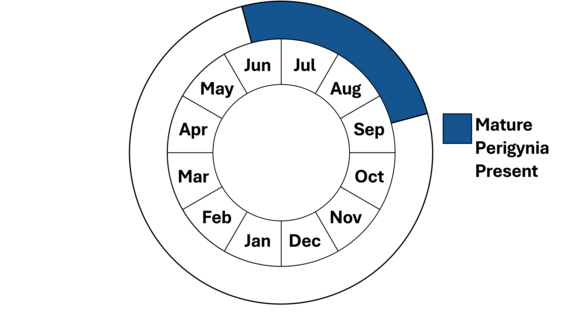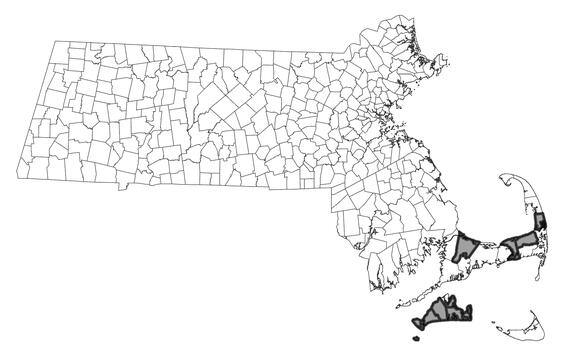- Scientific name: Carex mitchelliana M.A. Curtis
- Species of Greatest Conservation Need (MA State Wildlife Action Plan)
- Threatened (MA Endangered Species Act)
Description
Mitchell’s sedge is a perennial grass-like herb of the sedge family (Cyperaceae); it is a member of the Carex section Phacocystis. This wetland plant reaches up to 0.9 m (3 ft) tall. Flowering stems, or culms, form tufts arising from short underground rhizomes. The culms are scabrous, sharply three-angled, and erect with narrow, slightly hispid sheathing leaves. The leafy bases of this sedge are apparent throughout the year, becoming brown as winter approaches. The culms produce minute flowers in multiple cylindric, often drooping spikes. The hard fruits, or achenes, are closely enveloped within sac-like structures known as perigynia. Mitchell’s sedge was named in honor of Elisha Mitchell, a renowned 19th century botanist and geologist.
The leaves of Mitchell’s sedge are restricted to the basal portion of the stem. Leaves are generally shorter than the flowering culms and narrow, 5-9 mm (0.2-0.35 in) wide with fine hairs on the leaf sheaths. The upper one to three flowering spikes are staminate (male), and up to 7.5 cm (2.9 in) long. The lower two to four spikes are usually pistillate (female) and up to 8 cm (3 in) long and 7.5 mm (0.3 in) wide. The pistillate spikes often dangle from delicate stalks up to 3 cm (1.2 in) long. Pistillate scales are pale to coppery brown on the margins and usually 2.9-6.5 mm (0.11-0.26 in) long, including a scabrous awn up to 3.5 mm (0.14 in) long; the body of the scale is truncate toward the apex. The perigynia are ovate, lenticular, slightly beaked, and densely granular-papillate, 2.5-4.1 mm (0.1-0.16 in) long and up to 2.2 mm (0.09 in) wide. The perigynia also have two to five veins on both faces. The achenes are very small, up to 2.3 mm (0.09 in) long and 1.5 mm (0.06 in) wide, elliptic, lens-shaped, and deep reddish-brown to dark brown. Unlike similar species, the achene of Mitchell’s sedge does not have a constriction.
Mitchell’s sedge could be easily confused with two other members of Carex section Phacocystis, fringed sedge (Carex crinita), and drooping sedge (C. gynandra); both are closely related and are more common in Massachusetts wetlands. Unlike Mitchell’s sedge, fringed sedge has smooth lower leaf sheaths and smooth (or only slightly papillose) perigynia; one subspecies of fringed sedge, ssp. crinita, has a distinct constriction in the body of the achene, but ssp. brevicrinis does not. Like Mitchell’s sedge, drooping sedge has scabrous lower leaf sheaths; but unlike the rarer sedge, drooping sedge has achenes with a distinct constriction and does not have dense papillae on the perigynia. There are also less distinctive differences in carpellate scale morphology and perigynia shape among these three species; consult a technical key for more information.
Life cycle and behavior

Mature perigynia are typically present from early to late summer; however, phenology can vary, and sometimes they drop earlier. Achenes may be dispersed by birds or fall near parent plants and persist in the seed bank. Once established, populations may reproduce asexually from rhizomes.
Population status
Mitchell’s sedge is listed under the Massachusetts Endangered Species Act (MESA) as threatened. All listed species are legally protected from killing, collection, possession, or sale, and from activities that would destroy habitat and thus directly or indirectly cause mortality and disrupt critical behaviors. Mitchell's sedge has 13 populations that have been verified since 1999, on the coastal plain in Barnstable and Dukes counties. Nine additional populations have not been observed recently, including some in Plymouth and Nantucket counties.
Distribution and abundance
Mitchell’s sedge is uncommon throughout much of its range, which includes coastal Massachusetts to northern Florida, west to Pennsylvania and western Alabama.

Distribution in Massachusetts
1999-2024
Based on records in the Natural Heritage Database
Habitat
Mitchell’s sedge is a wetland species of the Massachusetts coastal plain. It inhabits forested swamps and occasionally wet meadows. It occurs on poorly drained organic and silty loam soils of level ground, stream banks, ditches, and levees that experience seasonal high-water tables. It is often found within small canopy openings inside of forested swamps. It typically occurs in areas where fresh groundwater seepage reaches the soil surface and is often associated with freshwater swamps adjacent to salt marshes.
Common plant associates include red maple (Acer rubrum), Atlantic white cedar (Chamaecyparis thyoides), black gum (Nyssa sylvatica), sweet pepperbush (Clethra alnifolia), arrowwood (Viburnum dentatum), cinnamon fern (Osmunda cinnamomea), skunk cabbage (Symplocarpus foetidus), bristly sedge (Carex comosa), swamp sedge (Carex intumescens), and orange jewelweed (Impatiens capensis). Mitchell’s sedge is sometimes associated with the native American reed (Phragmites australis ssp. americanus) as well as the invasive exotic common reed (Phragmites australis ssp. australis).
Healthy habitats are vital for supporting native wildlife and plants. Explore habitats and learn about conservation and restoration in Massachusetts.
Threats
Habitat destruction and degradation are threats to this species. This species is wetland dependent; changes in ground water and surface water hydrology may impact wetlands, microhabitat conditions, and soil moisture thereby causing shifts in plant community structure and composition. Habitats are susceptible to exotic plant invasions and competition from species such as common reed. Competition from exotic invasive and aggressive native species is a potential threat.
Conservation
This plant is wetland dependent, therefore maintenance of water quality and hydrologic regime are important for long term viability. Mitchell’s sedge populations require monitoring to better understand population dynamics, hydrologic influences, and threats at each site. This plant appears to be shade tolerant but is often reported in light gaps near fallen trees, on stream banks, or along moist embankments of ditches and levees within forested swamps. These small openings may allow more sunlight to reach the forest floor, enhancing flower production. Sites should also be monitored for invasions of competitive exotic and aggressive native plants; vegetation control may be necessary in some areas. All active management within the habitat of a rare plant population (including invasive species removal) is subject to review under MESA and should be planned in close consultation with the MassWildlife’s Natural Heritage and Endangered Species Program.
Contact
| Date published: | April 9, 2025 |
|---|